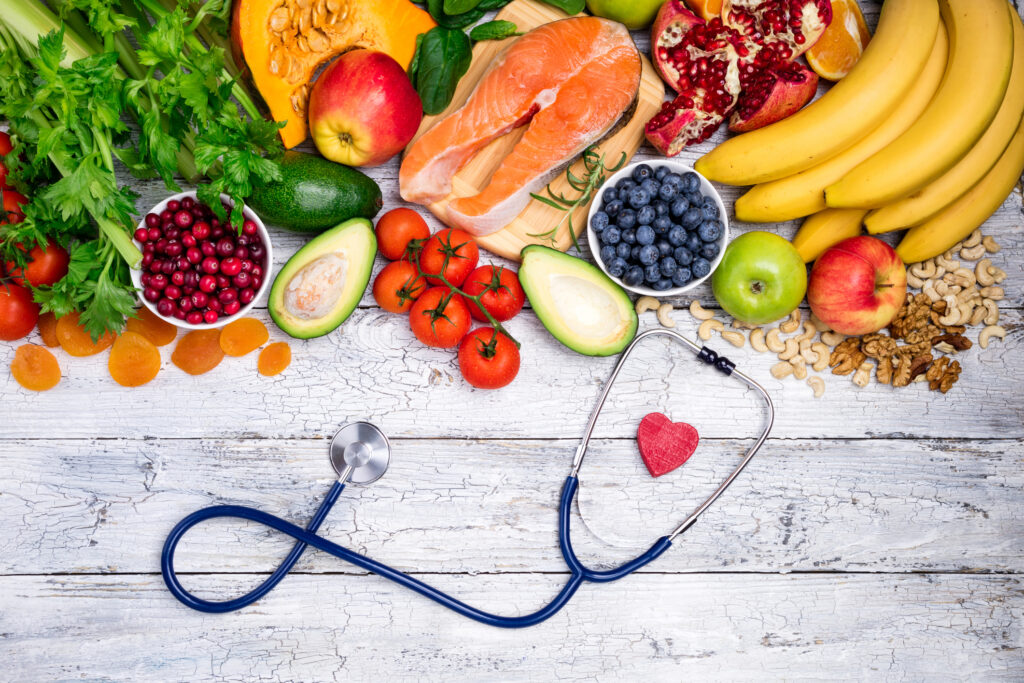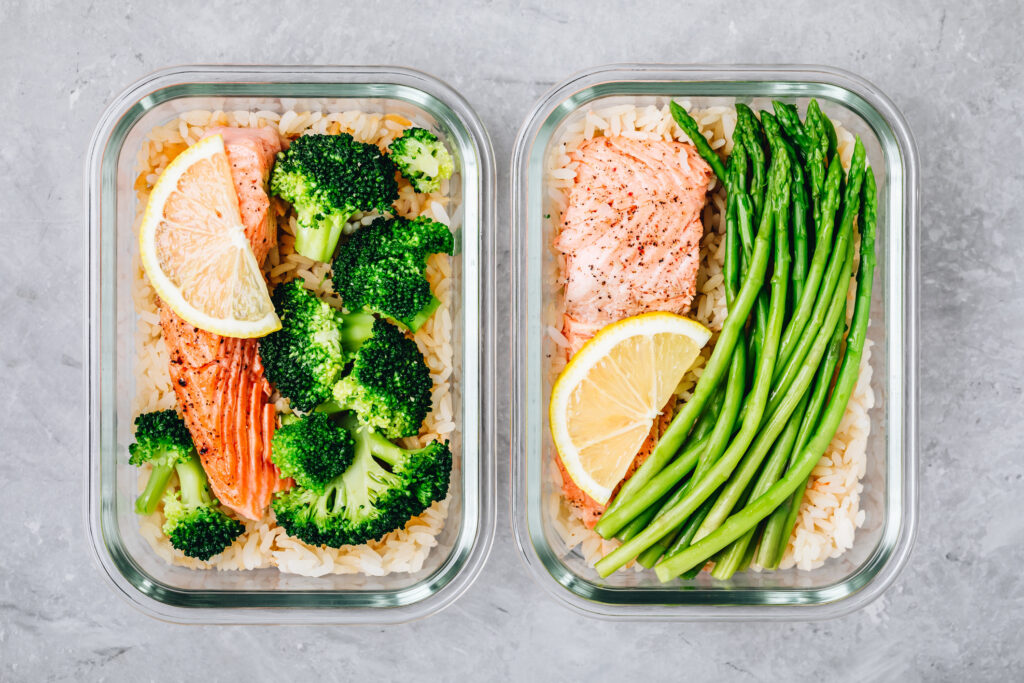You’ve heard it a million times: Eating heart-healthy foods is key to a healthy life. It helps you:
- Maintain your weight
- Reduce your risk for heart problems
- Get enough energy to power through your day
But what exactly does a heart-healthy diet entail?
It’s simple if you think about it in three easy parts:
- Eat healthy options,
- Limit unhealthy ones
- Watch your portions
Best of all, there’s plenty of room for likes and dislikes, dietary restrictions and even a small treat here or there.
To get started, think about your day-to-day meals and drinks—and all the small bites in between. And then consider how you can incorporate the three parts of heart-healthy eating into those choices, all day long.
What Heart-Healthy Foods Should I Eat?

First up on your path to heart-healthy eating, grab the good stuff.
According to the National Institutes of Health, an optimal heart-healthy diet covers a balance of five things:
- fruits and veggies
- whole grains
- fat-free or low-fat dairy
- proteins and
- healthy oils
These heart-healthy foods offer essential vitamins and nutrients your heart and body need—like potassium, magnesium and fiber. Eating them may help reduce the risk of high blood pressure and other problems that raise your risk for heart conditions.
- Fruits and veggies can be purchased raw, frozen, cooked or canned, but among the most nutritious and delicious ways to pack in produce is to eat it fresh. Leafy green salads (like kale or spinach) with fresh carrots and apples can be one easy way to get the good stuff. You can also add produce to other foods, like cooking an omelet with bell peppers or topping cereal with fresh berries.
- Whole grains include brown rice, plain oatmeal and whole-grain bread, tortillas and pasta. Check the label to make sure it’s really “100% whole grain”—sometimes packages say “wheat” or “multigrain” when they’re only partially made with whole grains.
- Fat-free or low-fat dairy includes milk, cheese and yogurt—and you can fit these items into any time of day. Milk goes great with oatmeal, for example, and string cheese makes for an excellent easy-to-grab mid-day snack at work. Yogurt works well as a substitute for sour cream, so level up your taco night with a healthy swap!
- Proteins can include fatty fish like salmon or trout as well as skinless chicken or turkey. But they can also include meatless options, such as eggs, nuts, seeds and lentils. Snacks and meals that include scrambled eggs, hummus, canned tuna and peanut butter are all protein-rich choices.
- Healthy oils include both foods and cooking oils that contain what’s called monounsaturated and polyunsaturated fats—these are “good fats.” Foods high in these good-for-you fats include nuts and nut butter, seeds, avocado and tofu. Healthy cooking oils tend to be liquid at room temperature and include safflower, olive, canola, corn and soybean oils.
What Foods Should I Limit?
You should also watch out for unhealthy options that can lead to plaque and other problems that raise your risk for heart issues. Keep things simple by cutting back on the following four categories.
- Saturated fats are not the “good” kind of fats (which are known as unsaturated fats). Instead, saturated fats are unhealthy fats that can come from whole-fat dairy like butter or cheese, as well as fatty meats like chicken skins. You can avoid saturated fats by choosing low- or no-fat dairy or picking leaner proteins like skinless poultry.
- Trans fats are foods made with an ingredient called partially hydrogenated oils. They can be in a wide range of foods, from frozen pizzas to coffee creamers. If the ingredient label includes “partially hydrogenated oils,” it’s best to steer clear.
- Added sugars sweeten desserts, drinks and even snacks that seem healthy (like granola bars). As of January 2021, all food labels must say how many grams of added sugar a food has, so be diligent when shopping.
- Sodium can be tricky since many foods sneak in unhealthy amounts of salt to improve the taste. You can outsmart those sneaky food manufacturers by being more aware of what you eat. Look for low- or no-sodium products, cook with herbs and spices instead of table salt, and make meals from scratch instead of using pre-made sauces or boxed foods.
That said, it’s okay to indulge in a small treat once in a while. As long as you limit these unhealthy options most of the time and keep moderation in mind, experts say an occasional unhealthy choice is just fine.
How Much Should I Eat?

Overeating can lead to weight gain, depleted energy levels and an increased risk for heart trouble. So when it comes to portion sizes, most doctors advise that you watch yours. But how do you know how much to eat and when to put the fork down?
The MyPlate initiative at the U.S. Department of Agriculture (USDA) can help. It advises these daily goals based on an average adult’s need for 2,000 calories per day:
- 2 cups of fruits
- 2.5 cups of veggies
- 6 ounces of grains
- 5.5 ounces of proteins
- 3 cups of low-fat dairy
- 5-7 tablespoons of oils (depending on your age)
These daily guidelines can help you keep portion sizes more reasonable. Still, your needs may vary depending on your age, weight and activity level. Ask your doctor for specific guidance, or check pages 139-141 of the USDA’s Dietary Guidelines for Americans for calorie goals unique to you.
Make a Plan for Heart-Healthy Eating
Eating heart-healthy foods doesn’t have to be complicated: If you aim for the good things, limit unhealthy foods and watch out for portions, you’re well on your way to improved heart health.
As you implement these good choices in your day-to-day, look for opportunities to make everyday meals and snacks more healthful. Trying new recipes is a great way to do just that: Each week, take some time to plan meals so that you can add ingredients to your weekly shopping list.
Fortunately, you can access an abundance of free heart-healthy recipes in every corner of the internet, from the National Institutes of Health to the American Heart Association. (Our picks include this delicious Caribbean casserole, chicken quesadillas with red and green salsa and quinoa breakfast bowl.)
So pick some dishes to try this week, make your shopping list and get going. A heart-healthy day awaits!
What are your favorite heart-healthy foods and recipes? Share in the comments.
This informational material shall not be considered medical or health advice. You should always consult your health care provider before changing your diet or starting a new exercise regimen. The Hartford assumes no responsibility for any decisions related to your medical or health care. Consult with your health care provider, nutritionist, or other health professional before making any decisions that may impact your health and well-being.






